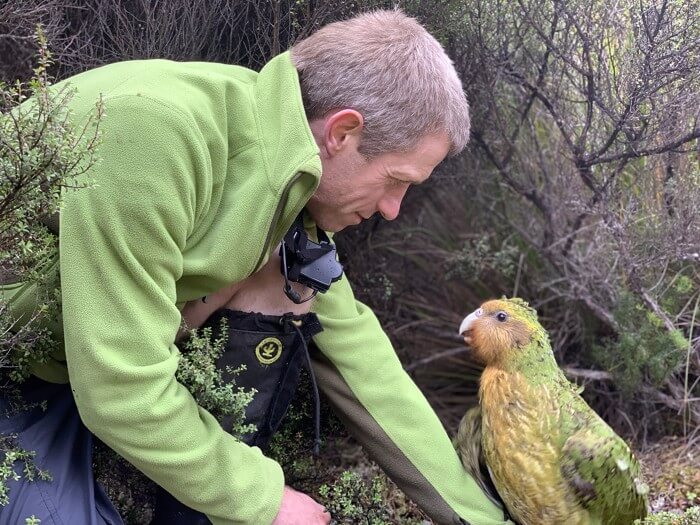The Kakapo
Class: Aves
Order: Psittaciformes
Family: Strigopidae
Genus: Strigops
Species: S. habroptilus
Lifespan: Average of 95 years
Sexing: The female can sometimes be distinguished from the male as she is smaller with a narrower head and a longer tail.
One of the strongest parrots in the world
A cumbersome, flightless parrot on the brink of extinction, the Kakapo has many unique characteristics that we think make it very interesting bird, especially being a parrot you could say it has broken a few records. An adult male Kakapo can weigh up to 4kg, making it the heaviest parrot in the world that’s the same as 4 large pineapples. Not only is it a nocturnal parrot, but also the only parrot that cannot fly. The Kakapo is ranked 2nd as one of the world’s ugliest animals.
Hide & Seek
Kakapo parrots have soft, moss-green feathers, with a bit of black on their back and yellow-green on their belly. This makes them excellent at blending in with them because of their unique musty odour making them mostly defenceless against cats and stoats, both of which were introduced to New Zealand.
Breeding is a boom
The male lets out an almighty ‘boom’ that carriers for up to five kilometres. Once the female is attracted she will then watch the male boom and decide whether he would be a good ate. The female will select a mate based on his boom performance.
Males make lousy fathers as they run off and leave the females to take care of the eggs. Females will incubate the eggs and when they’ve hatched she will fin food, leaving her chicks alone a contribution factor to their loss population, However this is not why they are critically endangered.
The diet
Kakapo parrots have a great sense of smell and can also swim. Being nocturnal animals they go out at night and forage eating the leaves and fruit of native trees. The kakapo would have been classed as a herbivore as it easts a wide range of leaves and berries. The Rimu berries are their favourite food and in the breeding season when there are ample amounts they will eat and feed their chicks on them almost exclusively.
A survivor against all odds
As ground dwellers, the Kakapo are easy prey. This is the main contributing factor that is drawing them closer to extinction. The European settlement in New Zealand is highlighted to be one of the biggest threats to the Kakapo survival. The introduction of new predators along with other animals competing for food, clearing of forests and increases in hunting – they never really had a chance!
Preservation of the Kakapo began in 1894 with the persistent efforts of Richard Henry. He relocated about 700 Kakapo and Kiwi birds to a predator free island where they lived in safety for sixty years. Unfortunately stoats were discovered on the island and restored the population. Now there are is only 126 known living kakapo left in the world, they have been relocated to predator free islands in an effort to restore the population, with constant monitoring.
Collectively over the past 20 years there has been a 70% increase in the number of kakapo parrots
In order for the Kakapo to survive and grow, it is estimated that 150 female Kakapos are needed to expand the Kakapo population. Unfortunately the Kakapo will need to live and breed on a predator free island, to live and breed on. Currently there are no large islands that are able to hold more than 100 Kakapos, This is a major issue as history has shown us, that even if the Kakapo are to reproduce without a large predator free island there species will become closer to extinction.

